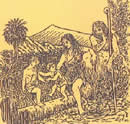People |
Long before the first European sailors arrived in the Canary Islands, all seven islands were inhabited. Guanches, meaning 'man' in the native tongue, was the name given to those inhabitants.
Guanches are thought to have arrived to the islands between the 1st or 2nd century B.C., probably from Africa. Linked to the Cro-Magnon period, they were tall, white-skinned, blue-eyed and blond-haired. |
The Guanches were cave dwellers, which seems to be a logical idea with regard to the climate of the Canary Islands. A cave would be ideal for both summer and winter, keeping people cooler or warmer, and also for storage.
But how did the Guanches arrive to the islands if there was no evidence of Guanche boats?
Actually, no one knows for sure, although people think that they were marooned there by pirates or perhaps exiled by their own people. Another theory says that they may have floated across from North Africa on reed craft. Ancient Canarian society was Stone Age, but not entirely primitive: they had a relatively sophisticated social structure. |
 |
 |
This varied from island to island, but most was divided into chiefdoms, ruled by a chief who was in turn advised by a council of elders. When discovered by the Spaniards, the natives belonged to a Neolithic culture, though they were advanced enough to have pottery. Their food staples consisted mainly of milk, butter, goat flesh, pork and some fruits. Their clothing comprised of leather tunics or vests made of plaited rushes. They left alphabet-like engravings and characters whose meanings are obscure. |
|










